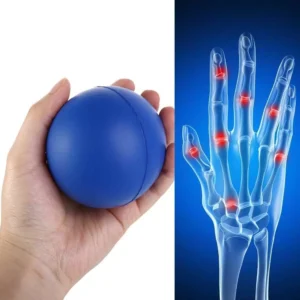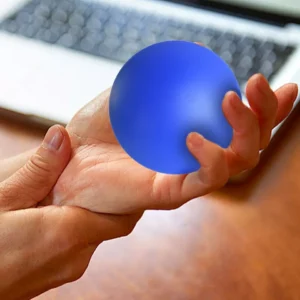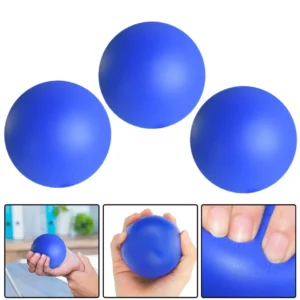Introduction
As healthcare moves toward more patient-centered care, there is a growing demand for portable rehabilitation equipment. Patients want to continue their therapy anytime, anywhere. This is especially important for hand therapy, where regular exercises can improve strength, and flexibility, and reduce pain. PU (Polyurethane) stress balls are an ideal solution among many portable rehab tools. They are lightweight, durable, and easy to use, making them perfect for hospitals, rehab centers, and home care.
For healthcare procurement professionals, choosing the right rehabilitation tools is key. The right tools can improve patient outcomes and optimize costs. This article will show why PU stress balls are the best choice as portable rehabilitation tools.
1. Why Portability Matters in Rehabilitation Equipment
1.1 Making Therapy Convenient for Patients
One of the biggest challenges in rehabilitation is getting patients to do their exercises regularly. Portable equipment, like PU stress balls, makes it easier for patients to fit therapy into their daily routine. They can use these stress balls at home, in a waiting room, or on a short break. This flexibility encourages patients to keep up with their exercises.
1.2 Supporting Home-Based and Outpatient Care
The trend toward home-based care is growing. More patients are doing therapy at home to save costs and make treatment more convenient. According to a report by Grand View Research, the global home healthcare market could reach $515.6 billion by 2027, with a large share of home rehab tools. PU stress balls are perfect for home-based therapy. They are easy to use and simple to store, and patients can use them on their own.
Tip for Buyers: Investing in easy-to-use, portable rehab tools like PU stress balls can help your facility provide better support for patients moving from hospital to home care.

2. Key Benefits of PU Stress Balls as Portable Rehab Tools
| Feature | Description | Benefit |
|---|---|---|
| Lightweight | Small and easy to carry, PU stress balls can be taken anywhere. | Patients can do therapy in any location, improving compliance. |
| Durable | Made from quality PU material, these stress balls keep their shape over time. | Cost-effective; reduces the need for frequent replacements. |
| Versatile | Available in soft, medium, and hard options to fit different therapy stages. | A flexible solution that meets various patient needs. |
| Easy to Clean | PU stress balls are easy to wipe down, meeting hygiene standards. | Suitable for both hospital and home use. |
2.1 Lightweight and Portable
PU stress balls are designed to be easy to carry. Unlike heavy rehab machines, these stress balls fit in a patient’s pocket or bag. This means patients can bring them anywhere. Being able to use them on the go encourages patients to stick to their therapy plan.
2.2 Durable and Long-Lasting
Hospitals and rehab centers need durable tools that can stand up to frequent use. PU stress balls are very resilient. They keep their shape and resistance even after months of use. For healthcare facilities, this durability means fewer replacements and lower costs over time.
2.3 Options for Different Therapy Needs
PU stress balls come in different hardness levels. This makes them ideal for patients at all stages of recovery. For example:
- Soft PU stress balls are great for patients starting therapy, especially if they have weak hand muscles.
- Medium PU stress balls provide a moderate challenge for patients who have gained some strength.
- Hard PU stress balls are ideal for advanced patients who need more resistance.
Tip for Buyers: Stock PU stress balls in different hardness levels. This gives your facility a flexible solution that can be used by patients with different needs.
3. Real-world examples of PU Stress Balls in Rehab Programs
Case Study 1: Helping Stroke Patients Recover at Home
A rehab center created a home-based program for stroke recovery. They included PU stress balls as part of the toolkit. Patients were told to use the stress balls three times a day. After eight weeks, 85% of the patients reported better hand strength and flexibility. Because PU stress balls are easy to carry, patients use them often, which speeds up their recovery.
Outcome: PU stress balls helped patients stay consistent with their therapy, leading to faster recovery.
Case Study 2: Managing Arthritis in Nursing Homes
In a nursing home, caregivers gave PU stress balls to residents with arthritis. The residents used the stress balls daily to reduce stiffness. After three months, 70% of residents had less joint stiffness and improved hand mobility. The stress balls were small enough to keep by the residents’ bedside, making them easy to access.
Outcome: PU stress balls proved to be a simple yet effective way to improve the quality of life for elderly residents.
Tip for Buyers: These examples show how PU stress balls can be used in different settings to support patient recovery. Adding PU stress balls to your rehab tools can improve patient satisfaction and outcomes.

4. How to Choose PU Stress Balls for Your Facility
4.1 Quality and Durability
Quality is essential for rehab tools. High-quality PU stress balls should keep their elasticity and shape, even after months of use. Durable tools mean fewer replacements, which saves money over time.
4.2 Different Hardness Levels
Patients at different stages need different resistance levels. Stocking a range of hardness levels helps ensure each patient has the right tool for their therapy.
Suggested Hardness Levels:
- Soft: For patients at the start of recovery with limited hand strength.
- Medium: For patients building strength and flexibility.
- Hard: For advanced recovery and strength training.
4.3 Safety and Hygiene Standards
Safety and cleanliness are top priorities in medical facilities. Choose PU stress balls that meet safety standards EN71. Also, make sure they are easy to clean and disinfect to meet hygiene standards.
Tip for Buyers: Ask suppliers for safety certification documents to confirm the products meet medical-grade standards.

5. Market Insights: Why Portable Rehab Tools Are in Demand
The global rehab equipment market is growing rapidly. According to MarketsandMarkets, this market is set to reach $50 billion by 2026. One key factor is the rising demand for home-based care. Portable tools like PU stress balls allow patients to do therapy both at home and on the go.
Additionally, a survey by the American Physical Therapy Association found that 60% of therapists recommend portable hand therapy tools. This trend highlights the growing need for tools that support patient convenience.
Tip for Buyers: Use market data to make informed procurement decisions. Investing in portable, patient-centered tools aligns with the latest trends in healthcare.
6. FAQs
Q1: Are PU stress balls suitable for all types of patients?
A1: Yes, PU stress balls come in different hardness levels, so they are adaptable for patients at any stage of hand therapy.
Q2: How do you clean PU stress balls?
A2: PU stress balls are easy to clean. You can wipe them with a mild disinfectant or soap and water.
Q3: Can PU stress balls be used in multiple settings?
A3: Yes, they are versatile and portable, making them ideal for hospitals, rehab centers, nursing homes, and home care.
Tip for Buyers: This FAQ section answers common questions, helping you make informed choices when purchasing PU stress balls.
7. Conclusion: Why PU Stress Balls Are a Smart Investment for Portable Rehab
Portable and patient-friendly tools are essential in today’s healthcare market. PU stress balls are ideal for hand therapy and recovery because they are lightweight, durable, and adaptable. For healthcare facilities, investing in PU stress balls can improve patient outcomes, reduce costs, and offer flexibility across different care settings.
Why Buy PU Stress Balls:
- Cost-Effective: PU stress balls are durable and long-lasting, providing high value over time.
- Easy for Patients: Patients can use them on their own, both in the clinic and at home.
- Flexible: With different hardness levels, PU stress balls are suitable for various therapy needs.
Adding PU stress balls to your rehabilitation program will give patients an effective tool for recovery and provide your facility with a cost-efficient, portable solution.
Recommended Product Specifications for PU Stress Balls
| Hardness Level | Recommended Patient Type | Specifications | Applications |
|---|---|---|---|
| Soft | Early-stage recovery, weak hands | 6cm – 8cm | Gentle squeezing |
| Medium | Moderate recovery | 7cm – 9cm | Flexibility and strength exercises |
| Hard | Advanced recovery | 8cm – 10cm | Grip strength and endurance training |
Tip for Buyers: Buy multi-packs with different hardness levels to provide a complete therapy solution for your facility.
Ask for a quote? Email me now!

